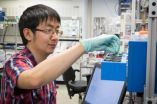(Press-News.org) Cells regulate protein functions in a wide variety of ways, including by modifying the protein structure. In an instant, a protein can take on another form and perform no or even the "wrong" function: in humans, proteins that fold wrongly can cause serious diseases such as Alzheimer's, Parkinson's or cystic fibrosis. Some of these proteins also have a tendency to "infect" other molecules of the same type and congregate into insoluble so-called amyloid fibrils or plaques. These amyloids can damage cells and tissues and make people ill.
Method breaks the shackles
Until now, there has been a lack of methods that enable structurally modified proteins to be recorded quantitatively in complex biological samples. Although there is a series of techniques to study structurally modified proteins, such as x-ray crystallography, nuclear magnetic resonance spectroscopy and other spectroscopic techniques, they cannot be used to analyse complex biological samples. Other procedures that researchers have used to study structural changes ofproteins in cells also have their limits: prior to the analysis, the proteins of interest have to be specifically marked to enable the scientists to observe them in samples. However, this approach is only possible for a few proteins in a sample.
The team headed by Paola Picotti, a professor of protein network biology, has now found a way to measure the majority of structurally modified proteins in any biological sample, which can contain thousands of different proteins. Picotti and her team have succeeded in measuring quantities of structurally modified proteins directly from a complex protein mixture as it occurs in cells, without cleaning or enriching the samples.
Combination of several methods
For their new method, the researchers combined an "old" technique and a modern approach from proteome research. First of all, familiar old digestive enzymes such as proteinase K are added to the sample, which cut the proteins depending on their structure into smaller pieces known as peptides. The fragments can then be measured using a technique which Picotti played a key role in co-developing during her time as a postdoc at ETH Zurich (as ETH Life reported). Known as Selected Reaction Monitoring (SRM), this method enables many different peptides to be sought specifically and their quantities measured. Based on the peptides found, proteins that were originally present in the sample can be determined and quantified.
What makes it so special: the digestive enzymes cut the same kind of proteins that have different structures in different places, resulting in diverse fragments. Like a fingerprint, these fragments can be clearly assigned to the individual structures of the protein.
"This means we can use the method to analyse structural changes of specific proteins or entire protein networks in a targeted fashion and measure numerous proteins at the same time," says Picotti.
Works for protein responsible for Parkinson's
Based on their new method, the researchers devised a test to specifically measure the "healthy" and "sick" versions of the protein alpha-synuclein in complex, unpurified samples such as blood or cerebrospinal fluid. Alpha-synuclein is thought to cause Parkinson's when its structure is modified. The pathological structural variety congregates with its own kind to form amyloid fibrils, which harm neuronal cells.
With the aid of the test, the scientists managed to measure the exact amount of pathogenic and non-pathogenic alpha-synuclein directly in a complex sample. The test also yielded information on the structure of the protein. "It shows us which parts of the protein change and turn into the new pathological structure," says Picotti.
Increasing number of amyloidoses
For the time being, the concentration of alpha-synuclein cannot be used as a biomarker as the levels of the protein are too similar in the blood or cerebrospinal fluid of Parkinson's sufferers and healthy people. "Nevertheless, it is possible that the ratio of pathological versus nonpathogenic alpha-synuclein structure changes with time, along the progression of the disease" suspects the ETH-Zurich professor. "As the new method enables us to measure both structures of the alpha-synuclein protein in a large variety of samples, it might be possible to use this to develop new biomarkers for this disease in the future," she hopes. Using the method, it might also be conceivable to discover other, as yet unknown amyloid-forming proteins that are connected to diseases without prior knowledge.
Both applications – the quantification of a specific known protein with a modified structure and the discovery of new proteins with variant structures – are highly relevant from a medicinal perspective, Picotti explains. "The number of amyloidoses, i.e. diseases that develop due to changes in protein structures, increases every year."
INFORMATION:
Feng Y, De Franceschi G, Kahraman A, Soste M, Melnik A, Boersema P, Polverino de Laureto P, Nikolaev Y, Oliveira AP, Picotti P. Global analysis of protein structural changes in complex proteomes. Nature Biotechnology, published online 14th Sept 2014, DOI: 10.1038/nbt.2999
Measuring modified protein structures
2014-09-15
ELSE PRESS RELEASES FROM THIS DATE:
UNC researchers find final pieces to the circadian clock puzzle
2014-09-15
CHAPEL HILL, NC – Researchers at the UNC School of Medicine have discovered how two genes – Period and Cryptochrome – keep the circadian clocks in all human cells in time and in proper rhythm with the 24-hour day, as well as the seasons. The finding, published today in the journal Genes and Development, has implications for the development of drugs for various diseases such as cancers and diabetes, as well as conditions such as metabolic syndrome, insomnia, seasonal affective disorder, obesity, and even jetlag.
"Discovering how these circadian clock genes interact has ...
Cheaper alternative to licensed drug for treating eye disease has similar side-effects
2014-09-15
Health policies which favour using ranibizumab for treating eye disease in older people over safety concerns for a cheaper alternative should take account of a new Cochrane Review published today. The researchers looked at the results of studies which compared the safety of two drugs used for treating age-related macular degeneration, ranibizumab and bevacizumab. Contrary to what was argued by some experts the review has found that the cheaper drug, bevacizumab, does not appear to increase deaths or serious side-effects compared with ranibizumab in people with neovascular ...
Study sheds new light on why batteries go bad
2014-09-15
Menlo Park, Calif. — A comprehensive look at how tiny particles in a lithium ion battery electrode behave shows that rapid-charging the battery and using it to do high-power, rapidly draining work may not be as damaging as researchers had thought – and that the benefits of slow draining and charging may have been overestimated.
The results challenge the prevailing view that "supercharging" batteries is always harder on battery electrodes than charging at slower rates, according to researchers from Stanford University and the Stanford Institute for Materials & Energy Sciences ...
Marijuana users who feel low get high
2014-09-15
PISCATAWAY, NJ – Adolescents and young adults who smoke marijuana frequently may attempt to manage negative moods by using the drug, according to a study in September's Journal of Studies on Alcohol and Drugs.
"Young people who use marijuana frequently experience an increase in negative affect in the 24 hours leading up to a use event, which lends strong support to an affect-regulation model in this population," says the study's lead author Lydia A. Shrier, M.D., M.P.H., of the division of adolescent and young adult medicine at Boston Children's Hospital.
She notes ...
Hypersensitivity to non-painful events may be part of pathology in fibromyalgia
2014-09-15
New research shows that patients with fibromyalgia have hypersensitivity to non-painful events based on images of the patients' brains, which show reduced activation in primary sensory regions and increased activation in sensory integration areas. Findings published in Arthritis & Rheumatology, a journal of the American College of Rheumatology (ACR), suggest that brain abnormalities in response to non-painful sensory stimulation may cause the increased unpleasantness that patients experience in response to daily visual, auditory and tactile stimulation.
Fibromyalgia ...
New knowledge of genes driving bladder cancer points to targeted treatments
2014-09-15
The story of cancer care seems so simple: find the mutated gene that causes cancer and turn it off or fix it. But rarely does a single gene cause cancer. More often, many genes are altered together to drive the disease. So the challenge becomes sorting out which altered genes are the most to blame in which cancers. A collaborative study between researchers at the University of Colorado Cancer Center and the National Cancer Institute (NCI) published today in the journal Clinical Cancer Research takes an important step toward answering this question in bladder cancer.
Specifically, ...
Identifying a better message strategy for dissuading smokers: Add the positive
2014-09-15
WASHINGTON — Which is more likely to convince a smoker to quit? The words, "Warning: cigarettes cause cancer" beneath the image of an open mouth with a cancerous lesion and rotten teeth, or the same image with the words, "Warning: Quitting smoking reduces the risk of cancer"?
The answer depends on how confident you are in your ability to quit, according to a study led by researchers at Georgetown Lombardi Comprehensive Cancer Center and published in the journal Nicotine & Tobacco Research.
The research, which involved 740 participants and three D.C. area institutions, ...
To curb violent tendencies, start young
2014-09-15
DURHAM, N.C. -- Aggressive children are less likely to become violent criminals or psychiatrically troubled adults if they receive early intervention, says a new study based on more than two decades of research.
These findings from researchers at Duke, Pennsylvania State and Vanderbilt universities and the University of Washington are based on the Fast Track Project, a multi-faceted program that is one of the largest violence-prevention trials ever funded by the federal government.
Beginning in 1991, the researchers screened nearly 10,000 5-year-old children in Durham, ...
Schizophrenia not a single disease but multiple genetically distinct disorders
2014-09-15
AUDIO:
New research shows that schizophrenia isn't a single disease but a group of eight genetically distinct disorders, each with its own set of symptoms. The finding could be a first...
Click here for more information.
New research shows that schizophrenia isn't a single disease but a group of eight genetically distinct disorders, each with its own set of symptoms. The finding could be a first step toward improved diagnosis and treatment for the debilitating psychiatric illness.
The ...
Vitamin E intake critical during 'the first 1,000 days'
2014-09-15
CORVALLIS, Ore. – Amid conflicting reports about the need for vitamin E and how much is enough, a new analysis published today suggests that adequate levels of this essential micronutrient are especially critical for the very young, the elderly, and women who are or may become pregnant.
A lifelong proper intake of vitamin E is also important, researchers said, but often complicated by the fact that this nutrient is one of the most difficult to obtain through diet alone. It has been estimated that only a tiny fraction of Americans consume enough dietary vitamin E to meet ...




